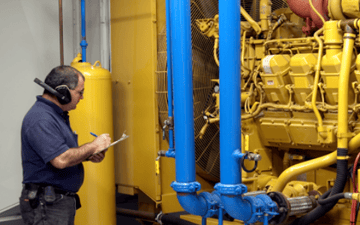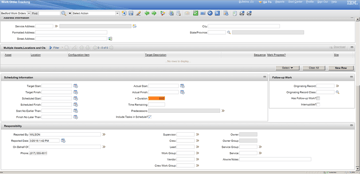Permitting, energy isolations, lock out tag out (LOTO) and risk assessments are integral elements in your organization’s daily processes and directly affect the safety of your colleagues and the success of your company. As someone who plays a role in any of these functions, there is a significant burden on your shoulders.
The systems and processes in which you work should help to shoulder that burden, rather than make it heavier. It should be easy and fast for you and your colleagues to go through routine safety tasks – without compromising on attention to details and accuracy. So, do your current tools and processes help you keep your maintenance technicians safe? Or do they make it a constant struggle to ensure that the proper permits are issued, the right energy sources are identified, isolated, and verified, and that all required people are involved throughout the process?
Here are seven features that you may not have thought of – but that will make a difference in your day-to-day efforts to keep your maintenance technicians safe and your organization productive.
Ask yourself… can your current system or process, (or maybe the new tool you’re evaluating) do the following?
1. Does Your Permitting Solution Help You to Master Shutdowns?
Shutdowns are difficult and time-consuming enough as-is. Does your permit solution allow templates to be created from previous shutdowns – including the isolation packages and linkages to all the associated permits and certificates? If so, you could save hundreds of hours of planning time and avoid creating duplicate content, such as risk assessments, isolation packages, and relationships.
You should also ask if your solution is integrated with your ERP, so that as the dates on work orders change, those changes are automatically synched with your permitting solutions. Often, the scheduled starts of a shutdown/turnaround/outage may change after scope approval. A function that integrates your permit requests and permits with the rest of the resource planning will save you hundreds of hours in manual updates.
2. Can Your Solution Generate Permit Requests Weeks – Or Even Months – In Advance With All the Work Scope Details and JSAs?
Tardy permit requests that are being created almost directly prior to the work are ineffective and, in the long run, more time-consuming. Planning “on the run” is far more open to human error and does not allow time to properly assess opportunities to minimize isolation effort through packing, nor to optimize return to service of the plan. (There’s a reason it’s considered poor practice!)
A solution that can automatically generate complete permit requests with all the necessary information will help your team plan and schedule optimally, ensuring nothing is overlooked.
3. Does Your Safe System of Work Integrate Seamlessly With Your EAM?
As you deploy your permitting solution across your organization – perhaps across multiple sites in various locations around the country or around the globe, how can you be sure your processes and best practices are being adhered to consistently from site to site? A solution that integrates seamlessly with your EAM ensures that consistency – say goodbye to the duplication of data and the potential errors this can cause. Crucially, integration also helps to facilitate communication between roles at your organization and leads to greater efficiency, because everyone has the information they need right at their fingertips.
4. Does Your Permitting Solution Automatically Cross-reference Your Data and Look For Potential Conflicts?
This is one of the manual and laborious elements of safety work that is both vitally important but also the most subject to human error. In your current processes, how easy would it be for a person to miss a vital conflict? And if there is a conflict, the most important question is: will you know about it?
Automatic cross-referencing highlights shared plant items and isolations plus any isolation point conflicts. This provides an early indicator of potential packages of isolations, merging of jobs on a permit or schedule separation to avoid conflicts of work.
A system with hazard conflict matrix identifies unsafe circumstances that exist within planned work, even if the conflicts exist on different permits. By analyzing the full work scope – work schedule, equipment, and hazards – your digital solution will compare permit outcomes and provide valuable feedback. A hazard matrix allows the site to define incompatible hazards and the checking function will highlight these conflicts in advance of work initiation, allowing potential schedule changes or required remedial work to be identified.
5. Does Your Permitting Solution Make Creating, Sharing, and Linking Isolation Certificates a Breeze?
Do your isolations schemes slow you down? Is your team stuck constantly repeating the same isolation certificate process – which is not only time-consuming, but inconsistent from person to person? In an ideal world, you’d have a library of Isolation Certificate Templates for different equipment and work, which could be used to create new Isolation Certificates for one or more permits. Such a library would not only make isolation planning more efficient, but would also instill consistency by implementing a proven safe method of isolating. Best of all, it will save your time and effort through the re-use of existing plans.
But at the end of the day, your Isolation Certificates aren’t nearly as useful and effective unless they can be shared by many permits or other isolation certificates and linked to package isolations so that they can be progressively rolled back during recommissioning, facilitating a faster return to service of the plant allowing production to re-commence sooner.
6. Is It Easy To Search Your Permitting System – Or Would You Be Going Through Mountains of Paperwork?
If you’re using a paper-based permitting process, our bet is that it would take a long time to find the permits, isolation plans, or LOTO that you need at any given moment. Effective permit retention and auditing practices require an effective digital solution that allows users to search on a range of criteria, including date, area, plant/system, equipment, and personnel.
Similarly, today’s Planners and Schedulers need a plotting search functionality, that allows them to view the location of permits in a timeline view. This highlights points of congestion and possible work conflicts with the ability to dig into the details of the individual permits, allowing for quick investigation and resolution of identified issues.
7. Does Your Solution Keep Everyone Who Needs To Be In-the-Know Informed in Real-time?
In a paper system, how do you make sure all relevant parties are kept up to date? How do Maintenance and Operations communicate? A properly designed digital safe system of work will have a robust email notification feature, which can trigger emails to advise when an action, such as an approval, is required on a specific permit request, permit or certificate. Or, if your digital solution has a mobile application, these communications would come in the form of push notifications. The right people are informed in near real-time, regardless of where they are, therefore reducing the delays in waiting for approvals and other actions.
Use a Permitting and Safety Solution to Manage Your Permitting Process
Does your existing permitting processes and tools have those features? If not, it’s time to consider how the status quo may be holding you back.
A digital, integrated safe system of work can help your organization achieve greater consistency, increased permit processing efficiency, and most importantly, better safe work outcomes.
Contact us today to find out how our Prometheus Permitting & Safety can increase the safety of your facility and help you increase your compliance.

